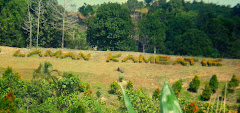
Two days ago , I drove my Toyota Hiace van to Tanjong Batu , looking for a perfect candidate for the next 'kambatik species' plant- the popular coconut tree. Lucky me! the morning sun was some what cloudy and not heaty. Nonetheless, the pictures turned out good.
Cocos nucifera ( Coconut)
Coconut is one of the most useful of all plants in Malaysia because of its multiplicity of uses both for local and commercial purposes. It grows naturally in tropical Malaysia because of its climate and sandy beaches. It does well too in warmer sub-tropical zones like in some parts of Australia.
Since it is planted throughout the world, its origin is mere speculation. However the centre of origin points to the Islands of the Pacific or Indian Ocean.

My favourite species is however a cultivar called, the Malay Dwarf. Coconuts are excellent street trees ( although it has the tendency to lean). It is also best to plant them in groups.

Coconuts tend to be slow in establishing but once rooted deep after half a year, its subsequent growth is rapid. It needs well drained soil. From these pictures it is proven that they do not merely 'grow close to the sea'.

Coconut trees can grow to a full height of 5 meters - 30 meters , depending on the species or cultivar. In the picture above you can see that they can be bought in quite big size polybags at any good nursery.

Pix above shows The Malay Dwarf fruiting luxuriously.
In the Malaysian context, we should plant more of these trees because they are symbolic of Malay kampungs . Its swaying leaves( fronds) suggest a welcoming gesture and even if you need to leave the kampung , the leaves will keep swaying you goodbye.!In fact its their over topping graceful crowns above the kampung rooftops and other vegetation that makes it the hallmark of the tropics. Thus , I highly recommend coconut palms to make the kambatik garden authentically tropical.
Reference:
1) Natalie W.Uhl & John Dransfield(1987) Genera Palmarium.Allan Press, Lawrencence, Kansas.
2) David Jones(1984) Palms in Australia. Reed Books Pty Ltd. Singapore)

No comments:
Post a Comment